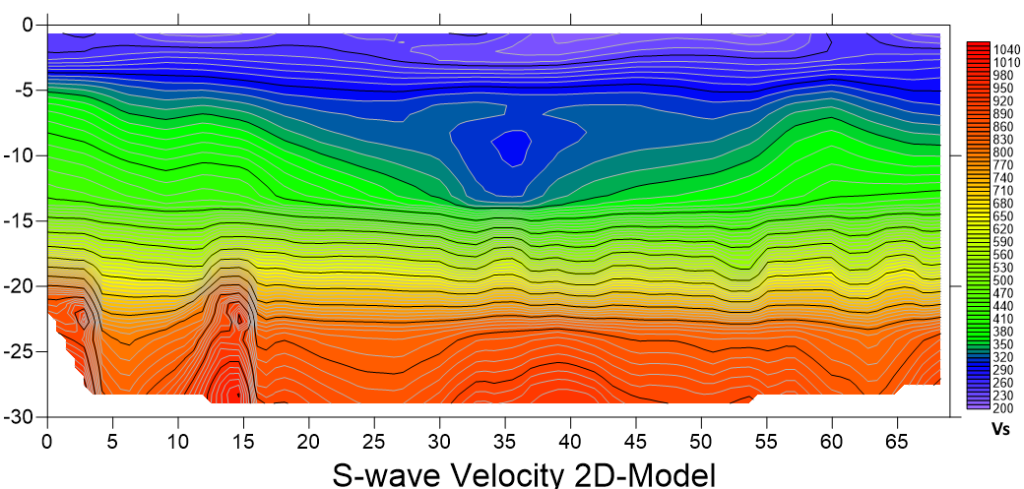Surface Seismic Sounding
Features of Surface Seismic Soundings
- Sometimes referred to as MASW, but Sitka’s performance is significantly more elaborate
- Vs and Vp profiling for seismic site classification (Vs30), without a borehole
- Entirely from surface, non-invasive, risk free, no permitting required
- 2D Profile up to 60m in depth, but most reliably to 40m
- Bedrock Profiling included
- Ground stiffness evaluations and Slope Stability Analysis
- Delineation of “soft zones”, potential voids, other anomaly detection
- Elastic Modulus: Poisson’s Ratio, Shear, Young’s, and Bulk Moduli
The Survey
- Often called MASW, but this is a significant understatement to the methodology which Sitka performs
- 7 geophysical methods used in one survey:
2D MASW – 2D Profile of Vs shear wave velocities for the upper ~40m
MAM – Passive for collecting deeper features of Vs
2D SRT – 2D Profile of Vp compressional wave velocities for rock and water table features
HVSR – Excellent corroborating data for confirming bedrock and other stiff layers
ARI – Acoustic Resonance Imaging which generates 2D profiles of overburden layers, especially effective
S-Wave Reflection – Additional 2D profile of overburden, rock fractures, weathering and bedrock
EFWI – A computer processing algorithm used to clarify data sets and profiling imagery - The equipment used is also far above what is typically used for an “MASW” test. Sitka uses broadband geophones, which are capable of imaging hundreds of meters into the earth and often used for far more intricate studies than a simple Seismic Site Class Vs30 test.
- While a 1D result will always be included, a 2D profile of the site will most completely capture seismic data.
Advantages
- SPT and CPT always must use a conservative value for Seismic Site Class – so the lowest value on the span of values which encompass a site class letter. A Site Class D, determined by SPT and CPT will be 180m/s. Using geophysical methods, like Surface Seismic Soundings, the Vs30 of a site will always be higher, even if the site class is a D. From a structural engineers perspective, the difference between a 180m/s Vs30 versus a 240m/s Vs30 is significant. The cost saving for the end client can be incredibly large
- Surface Seismic Soundings will never encounter refusal conditions, permitting, unsafe conditions, or risk factors for cost.
Comparison of Our Non-Invasive Geophysical Methods Against Invasive SPT, CPT, DCPT & SCPT
| Criterion | Surface | Invasive Drilling Methods |
|---|---|---|
| Data Continuity & Resolution | High (continuous velocity profile) | Low (discrete point data) |
| Site Disturbance | None | Moderate, drilling |
| Spatial Representativeness Depth of Measurement | Broad, integrated over surface and depth 40m in depth for the highest resolution | Limited to single-point measurements No limit of depth, but point based |
| Cost | Lower, $2,700 typically, all in | Higher, about $6,000 for SCPT >$9,000 for Crosshole |
| Safety and Accessibility | Very Safe (no heavy equipment required, not one injury or near-miss to date) | Less safe (rigs, deep access needed, hydraulics) |
British Columbia adheres to the National Building Code of Canada (NBCC) seismic site classification system, which categorizes sites based on their dynamic response characteristics. The classification scheme, summarized below, directly informs the seismic design forces specified in the BC Building Code:
| Site Class | Type | Vs₃₀ Range (m/s) |
| A | Hard Rock | >1500 |
| B | Rock | 760-1500 |
| C | Very Dense Soil/Soft Rock | 360-760 |
| D | Stiff Soil | 180-360 |
| E | Soft Soil | <180 |
| F | Special Soils | Site-specific (typically organics, peat) |


